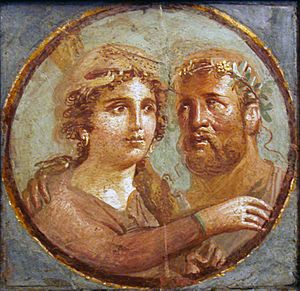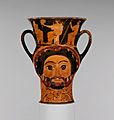Heracles facts for kids

Heracles (Latin: Hercules) was a very important hero in Greek mythology. He was known as the greatest of all Greek heroes. Heracles was the son of the powerful god Zeus and a human woman named Alkmene. Even as a baby, Heracles was incredibly strong and brave. When he grew up, he wore a lion's skin, carried a club made of olive wood, and was a skilled archer with his bow and arrows.
Hera, the Queen of the Gods, did not like Heracles at all. This was because he was Zeus's son with a human. She created many difficult challenges for Heracles, hoping they would lead to his death. These challenges are known as The Labors of Heracles. But Heracles completed every single one successfully. Because of his bravery, Zeus made him immortal. He had many exciting adventures throughout his life. After he died, he went to live with the gods on Mount Olympus.
People all over the Greek world admired Heracles. He was especially popular among athletes. This is because he was seen as the god of gymnasiums and wrestling schools. He is even said to have started the Ancient Olympic Games. He also marked out the length of the Olympic stadium. The Romans called him Hercules. Heracles has been a popular subject in art for a very long time. He has also appeared in movies, like Walt Disney's Hercules.
Contents
Heracles' Birth and Early Life
Zeus was the most powerful of all Greek gods. He fell in love with a beautiful human woman named Alkmene. She gave birth to his son, and they named him Alkides. Later, he would be known as Heracles. Alkmene lived in the city of Thebes.
Zeus's wife, Hera, was very angry that her husband had a child with another woman. She hated Heracles and constantly looked for ways to harm him. The goddess Athena felt sorry for the baby. She cleverly tricked Hera into feeding baby Heracles. This was an important step on his path to becoming immortal. Hera's hatred for Heracles grew even stronger. She sent two dangerous snakes to attack him in his crib. But the baby Heracles, showing amazing strength, killed both snakes with his bare hands. This was his very first act of great courage and physical power.
Heracles as a Teenager
Heracles grew into a very strong teenager. He learned how to use weapons and how to drive a chariot. One day, he accidentally killed his music teacher, Linus. This happened because the teacher tried to hit him. Heracles said he was acting in self-defense, and he was set free. However, people were a bit scared of him. So, he was sent far away from the city to work on a farm. The hard work made Heracles even stronger. He grew to be seven feet tall. He was eighteen years old when he finally left the farm.
The Lion of Kithaeron
When Heracles was eighteen, he went to hunt a huge and powerful Lion that lived on Mount Kithaeron. This lion was attacking cows in a nearby land. The hunt lasted for fifty days. It ended when Heracles used a club made from olive wood to smash the lion's skull. This special club is often shown in pictures of Heracles. After defeating the lion, he wore its skin as a cloak.
On his way back to Thebes, Heracles met some messengers from King Erginus. They were going to Thebes to collect tribute (a payment). They treated Heracles with disrespect. King Erginus later started a war against Thebes. But Heracles defeated and killed Erginus. Because he saved Thebes, King Kreon gave his daughter Megara to Heracles in marriage.
Heracles' Great Sadness and His Labors
Hera could not stand how famous and loved Heracles was becoming. Her anger and hatred made her act foolishly. She tricked Heracles into believing his own sons were his enemies. Filled with terrible anger, he harmed them.
When he realized what he had done, Heracles was filled with deep sadness. He left everyone and lived alone for a while. He sought advice from the Oracle of Delphi. The priestess told him he must serve King Eurystheus, who ruled Tyrins in Mycenae. She said this service would cleanse him of his terrible actions.
King Eurystheus was not a good person, and Heracles disliked him. Eurystheus gave Heracles a series of tasks to complete. These tasks became known as "The Labors of Heracles." It was said that Hera herself designed these tasks. She hoped they would finally kill him. But Zeus had promised that if Heracles successfully completed the Labors, he would become immortal.
Images for kids
-
Greek mythology influenced the Etruscans. This vase at Caere shows King Eurytus of Oechalia and Heracles in a symposium, around 600 BCE.
-
Side of a terracotta kantharos (drinking cup) shaped like the head of Heracles, from about 470 BC.
-
Heracles and the Ceryneian Hind, a sculpture by Lysippos.
-
Death of Hercules (painting by Francisco de Zurbarán, 1634, Museo del Prado).
-
A depiction of the Zoroastrian god Bahram as Hercules, carved in 153 BCE at Kermanshah, Iran.
-
Herakles wearing his lion skin and holding a thunderbolt (vajra), with Buddhist monks, from the art of Gandhara, British Museum.
See also
 In Spanish: Heracles para niños
In Spanish: Heracles para niños









